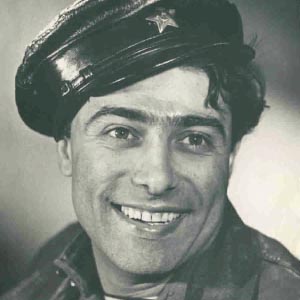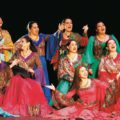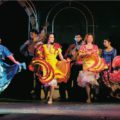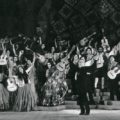- Фото © Театр «Ромэн»
- Фото © Театр «Ромэн»
- Фото © Театр «Ромэн»
The Romen Theatre is the only professional Romani theatre in the world. For 90 years, the theatre’s productions have successfully blended vivid Romani culture with the techniques of the Russian school of drama.
Romani music culture is centuries old and their singing and dancing has always delighted the public. In 18th-century Russia, Romani choirs became increasingly popular. The chorus of Count Alexei Orlov, directed by Ivan Trofimov, was particularly famous. The chorus sang Russian songs but their manner of singing gave the words and music a deep, almost exotic emotionality.
After 1812, parade dinners in taverns came into vogue, to which the Romani chorus was often invited. These concerts made the Yar restaurant famous in the 19th century. By the end of the 19th century, the development of Romani performances rose to such a level that the head of the choir, Nikolai Shishkin, created the first Romani theatre troupe. However, the history of the actual theatre started a little later, in the 1930s.
The Birth of the Theatre
Georgy and Ivan Lebedev, young men from a family line of Romani choir singers, are credited with the idea of creating a Romani theatre. With the support of Anatoly Lunacharsky, People’s Commissar of Education, an Indo-Romani Theatre Studio was established by decision of the Ministry of Education. On December 16, 1931, after the premiere of the first performance “Life on Wheels”, based on the play by Alexander Germano, the studio was reorganized into the Romen Theatre . Georgy Lebedev became the theatre’s director, Moses Goldblat became the artistic director, and Ivan Rom-Lebedev, who added the prefix “Rom” to his surname, became one of the leading actors and playwrights.
A turning point in the history of the Romen Theatre was in 1937, when the theatre was headed by Mikhail Yanshin, an actor from the Moscow Art Theatre. Prior to Yanshin, the theatre had only staged original plays by Romani playwrights in the Romani language. Yanshin expanded the repertoire with works of Russian and foreign classics. Plays began to be performed in Russian, which attracted a new audience to the theatre. Yanshin sought to combine folklore with great dramaturgy. These principles were also refined by the next director of the Romen theatre, Pyotr Saratovsky. Under his leadership, the theatre worked throughout the Great Patriotic War.
The Heyday Era
The Romen Theatre had its golden age in the 50s. From the 1950s-70s, chief director Semyon Barkan introduced new authors and productions into the repertoire. Then, in 1977, Nikolai Slichenko took over the theatre.
In 1977, Slichenko and Rom-Lebedev staged “We are the Gypsies”, which remains the theatre’s “calling card” and opens each theatre season. The creators themselves defined the genre of the play as a “folk musical spectacle”. The production tells the story of the wanderings of the Romani people, from their exodus out of India and Egypt to finding their homeland in Russia. It is a musical and dance extravaganza featuring the most famous Romani characters, Esmeralda and Carmen, Grushenka and Masha. The Romani temperament on stage expresses itself in different forms, including through Arabian belly dance, passionate flamenco, and a heartfelt romance with a guitar. The stage sets by Sergei Barkhin and costumes by famous fashion designer Vladimir Zaitsev add a special splendour to the action.
The musical theatrical show “Droma Romen” (“Romani Roads”) is another hit on the theatre’s poster. Young director Nikolai Lekarev proposed a modern interpretation of the main elements of Romani culture, focusing on music rather than theatrical action. The story of Romani migrations from country to country is told with the help of musical numbers, such as flamenco, jazz manouche, bili-dance, and khat-hat. At the same time, the actors’ black and white costumes are laconic in a modern way, without motley skirts and shawls. The thoughtful viewer will surely find references to the play “We are the Gypsies” in “Droma Romen”and will be surprised by how easily the old culture of Romani song and dance is integrated into the realities of the 21st century.
The country’s main Romani
Nikolay Slichenko is a cult figure, not only for the Gypsy theatre, but also for Soviet art of the 70–80s. He is a People’s Artist of the USSR, laureate of the State Prize of the USSR, laureate of the Prize of the Government of the USSR, and holder of many governmental awards. Born in 1934, his childhood coincided with the war years, and the most terrible shock for the boy was the execution of his father by the Nazis. But no misfortune could break the character of a true Romani. In the post-war years, Nikolai worked on a Romani collective farm in the Voronezh Province, and sang and danced so fiercely at village gatherings that fellow villagers gifted the young talent a ticket to the Romen Theatre in Moscow! The 17-year-old joined the supporting cast, and a year later, he was already playing in the main ensemble. According to legend, Nikolai had to cheat to get on stage.He persuaded his fellow actor Shishkov to pretend to be ill, then replaced him in the play “The Four Grooms”. After this premiere, the young actor confidently established himself in the troupe. Slichenko made his mark on the big stage around the same time as the theatre itself. In 1962, he performed a song in Ryazan to the lyrics of Sergey Yesenin’s “Letter to Mother” and broughtthe audience to tears. “It literally shook me,” Slichenko recalled. “After that memorable concert, for the first time, I seriously thought about my future work on the stage, about the repertoire, about the artist’s responsibility to perform a song in front of a wide audience”. Slichenko always sang with great inner commitment and sincerity. There was no pretense; everything was like for the last time. And there was a reason whole stadiums gathered to hear him. The public knew Nikolai as a movie actor. His roles were few, but memorable. For example, his role as Red Army soldier Petri Bessarabets in the movie “Wedding in Malinovka” made the actor popular throughout the country. Surprisingly, despite this acclaim, Slichenko always put the Romen Theatre first, both as an actor and as a director. His performances centred around the theme of man. For example, in the play “Grushenka”, he created a completely new narrative about the tragic fate of the young Romani girl Grushenka, adding an anxious and romantic tone to the well-known story. Slichenko not only prepared new performances and took the troupe on tour, but also cared about the influx of new personnel. In 1978, he created a studio at Gnessin State Musical College that trained actors for the Romen Theatre. In 2005, he launched the Romani National Course at the Boris Shchukin Theatre Institute and became its Artistic Director. Nikolai Slichenko directed the Romen Theatre from 1997 until his death in the summer of 2021. One could say that a whole era came to an end with the legendary actor’s passing. But the theatre lives on, along with the eternal art of Romani song and dance.

Nikolay Slichenko: “I remember at that time “The Living Corpse” came out in four theatres at once — besides us, it was also in the Maly Theater, the Moscow Art Theater, and the Mossovet Theatrе. And there was a joke going around Moscow that of the four “corpses”, the liveliest was in the Romen Theatre.”
We are Gypsies!
90 years have passed since the foundation of the Romen Theatre. The repertoire, scenic solutions and technology have all changed, but the national character of the theatre has not changed at all. Today, more than 90% of the troupe are real Romani. There are many acting dynasties in the theatre, including the Pearls, the Oglu, the Lekarevs. So, how can one define Romani theatre? Well-known actor Georgiy Zhemchuzhny explains it this way: “Not to take care of ourselves, but to burn now, in front of the audience — that is our state of mind”. And this is true. The characters on the Romen stage cannot express something with a simple gesture or a word. To speak of hatred or love, they always need a song or a dance, and the emotions must be literally overwhelming. Perhaps this is what allows the Romen Theatre to remain the centre of preservation and development of the Romani culture, not only in the Russian Federation, but all over the world.
Tatiana Borisova



